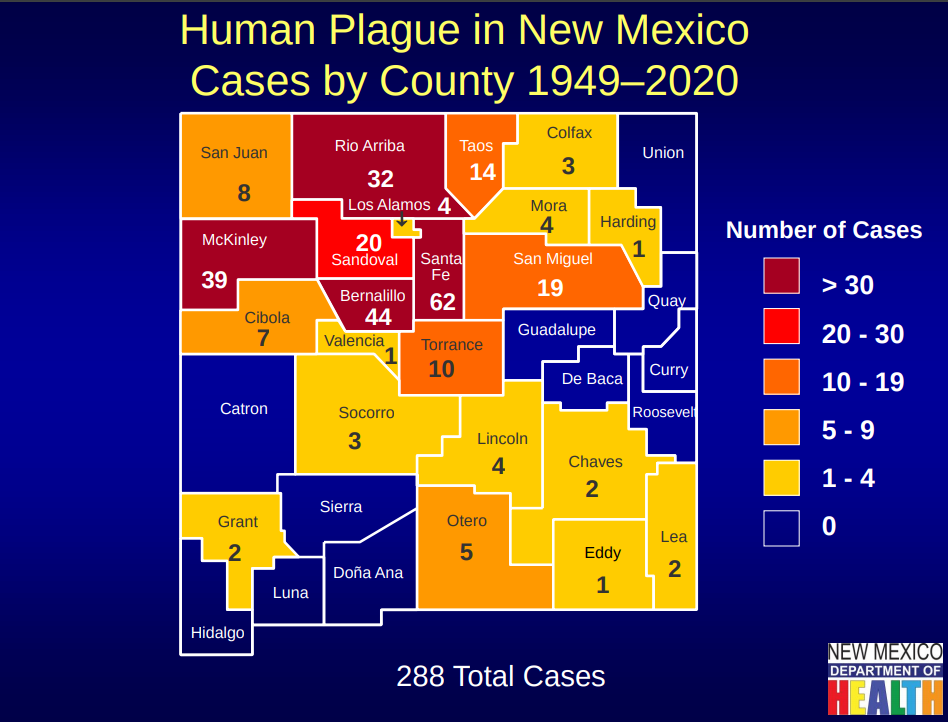
The New Mexico Department of Health (NMDOH), on Friday, August 20, reported the state’s first human Bubonic plague case of 2021. It is the second incident of the disease verified in the US this year.
The case was confirmed by the New Mexico Scientific Laboratory. The infected patient resides in Torrance County, is being treated at a local hospital and is expected to fully recover.
About the state’s newly confirmed case, the NMDOH states, “the person was most likely exposed to flea bites brought home by a pet.” The department also comments, “an environmental investigation will take place at the person’s home to look for ongoing risk to immediate family members, neighbors and others in the surrounding community.”
Plague Occurs Annually in the US
According to the Centers for Disease Control and Prevention (CDC), although plague is a rare disease, cases occur annually in the US. About half of them are in New Mexico. Arizona, California, Colorado, Oregon and Nevada are other states where breakouts commonly occur.
This year’s first reported case of human Bubonic plague was in Colorado. The infected individual, a ten-year-old child, did not survive.
What is Plague?
Plague is a potentially deadly, infectious disease caused by Yersinia pestis bacteria. Normally, the disease affects wildlife, especially rodents. Humans and house pets usually contract the disease after being bitten by infected fleas.
However, according to the CDC, transmission can also evolve as a result of “direct contact with infected tissues or fluids while handling an animal that is sick with or that has died from plague. Finally, people can become infected from inhaling respiratory droplets after close contact with cats and humans with pneumonic plague.”
The Three Types of Plague
According to the CDC, if bitten by an infected flea, a person would experience “one of three presentations” – bubonic infection (high fever and swollen lymph glands), pneumonic infection (high fever, chills, cough, bloody sputum) or septicemic infection (fever, exhaustion, hemorrhagic or thrombotic phenomena, progressing to gangrene on the skin).
Of the three possibilities, bubonic plague is the most common.
Number of Plague Cases in New Mexico
Even though the number of plague cases New Mexico experiences is low, only 288 from 1949 – 2020, two of which have been in Lea County, the disease should be taken very seriously. The plague killed more than 25 million people across Europe from 1347 – 1351. According to the World Health Organization (WHO), case fatality of the bubonic type is between 30 – 60 percent. Fatality is almost 100 percent with the pneumonic type.

A Vaccine is Being Tested
The same UK scientists who are behind the AstraZeneca vaccine for COVID-19 are working on a vaccine for the plague. They are using technology similar to that of the coronavirus vaccine. The first trial on humans of the new plague vaccine is underway
Forty healthy individuals between the ages of 18 – 55 are participating in the trial.
Everyday Prevention
Time will tell the effectiveness of the new vaccine. Until more research is completed, prevention is the best protection, and the NMDOH offers these everyday guidelines to New Mexicans.
Avoid contact with “wild rodents and their fleas, nests and burrows.”
Do not allow pets to hunt or roam.
Regularly treat pets with vet approved products that control fleas. Remember that not all products are safe for cats, dogs and/or children.
Always wear rubber gloves when handling game.
Eliminate areas around your home where rodents can live – abandoned vehicles, brush, wood and junk piles.
Place compost, hay and wood piles as far away from your house as possible.
Use “rodent proof containers” for storing animal food, and place food and water for your pets where rodents and wildlife cannot get to them.
Have sick pets promptly examined by a vet-
Go to your doctor if you have an unexplained illness involving a sudden and severe fever.
Sharing a bed with pets is a perfect breeding ground for human infection of plague.
More Information The NMDOH website provides detailed information in both English and Spanish about the plague. You can also learn more from the CDC and WHO websites.
Photo by Svetozar Cenisev / Unsplash


